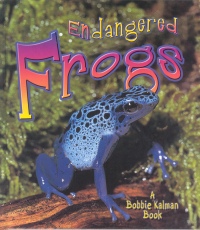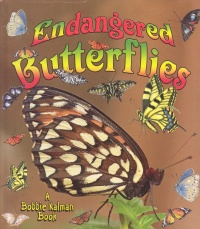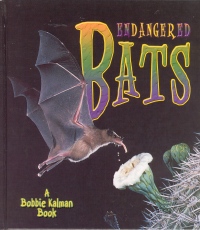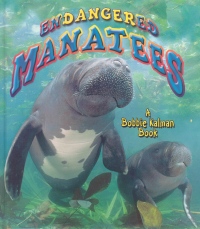| ________________
CM . . .
. Volume XIII Number 5 . . . .October 27, 2006 
 |
Endangered Frogs. (Earth’s Endangered Animals).
Bobbie Kalman & Molly Aloian.
St. Catharines, ON: Crabtree, 2006.
32 pp., pbk. & cl., $8.06 (pbk.), $20.76 (RLB.).
ISBN 0-7787-1918-9 (pbk), ISBN 0-7787-1872-7 (RLB.).
Subject Headings:
Frogs-Juvenile literature.
Endangered species-Juvenile literature.
Grades 3-6 / Ages 8-11.
Review by Harriet Zaidman.
**** /4
|
| |
|
 |
Endangered Butterflies. (Earth’s Endangered Animals).
Bobbie Kalman & Robin Johnson.
St. Catharines, ON: Crabtree, 2006.
32 pp., pbk. & cl., $8.06 (pbk.), $20.76 (RLB.).
ISBN 0-7787-1916-2 (pbk), ISBN 0-7787-1870-0 (RLB.).
Subject Headings:
Butterflies-Juvenile literature.
Endangered species-Juvenile literature.
Grades 3-6 / Ages 8-11.
Review by Harriet Zaidman.
**** /4
|
| |
|
 |
Endangered Bats. (Earth’s Endangered Animals).
Bobbie Kalman & Kristina Lundblad.
St. Catharines, ON: Crabtree, 2006.
32 pp., pbk. & cl., $8.06 (pbk.), $20.76 (RLB.).
ISBN 0-7787-1912-X (pbk), ISBN 0-7787-1866-2 (RLB.).
Subject Headings:
Bats-Juvenile literature.
Endangered species-Juvenile literature.
Grades 3-6 / Ages 8-11.
Review by Harriet Zaidman.
**** /4
|
| |
|
 |
Endangered Manatees. (Earth’s Endangered Animals).
Bobbie Kalman & Hadley Dyer.
St. Catharines, ON: Crabtree, 2006.
32 pp., pbk. & cl., $8.06 (pbk.), $20.76 (RLB.).
ISBN 0-7787-1914-6 (pbk), ISBN 0-7787-1868-9 (RLB.).
Subject Headings:
Manatees-Juvenile literature.
Endangered species-Juvenile literature.
Grades 3-6 / Ages 8-11.
Review by Harriet Zaidman.
**** /4
|
| |
|

excerpt:
Manatees have few natural predators. Predators are animals that hunt other animals for food. The actions of people put manatees in great danger. Millions of people live in or visit areas near manatee habitats. Many of the people act in ways that harm manatees. (From Endangered Manatees.)
The effect of humans on the natural world is the major reason the animals discussed in this series are in danger of extinction. From expanding settlement to use of pesticides to clear cutting, human activity is changing the world dramatically. The unique features and habits of each animal are discussed, but 12 of the 32 pages in each of these books are devoted to the issue of what threatens their survival.
This series, “Earth’s Endangered Animals,” published by Crabtree, follows the company’s standard format of two-page chapters which contain both photos and drawings on coloured backgrounds. The text is set on white, with bolded words defined in a glossary at the back of the book, on the same page as an index. The bright, close-up action shots of frogs snapping up dragonflies out of the air or thousands of bats packed together in a nursery colony will fascinate young children who are eager to learn about the natural world.
The facts about the animals’ physiology, habitat and habits are interesting and well explained:
Butterflies are pollinators, or animals that help spread pollen from plant to plant. Pollen is a powdery substance found in flowers. Flowers need pollen from other flowers to make seeds. As a butterfly drinks nectar from a flower, pollen from the flower often sticks to the butterfly’s body. When the butterfly flies to another flower to drink nectar, it carries the pollen with it on its body. Some of the pollen may rub off on that flower. (From Endangered Butterflies.)
Most importantly, the books educate children about why these animals have become endangered, making no excuses for irresponsible human behaviour.
Some people use chemicals, including pesticides and fertilizers, on their crops, gardens and fields. These chemicals get into the water and soil and damage frog habitats. As frogs absorb oxygen and moisture through their skin, they also absorb the harmful chemicals, which can cause them to become sick or to die. When tadpoles and the embryos inside frog eggs absorb the chemicals, they may also die. The embryos and tadpoles that do survive often do not grow properly. Frogs that do not develop properly may not be able to mate and lay eggs. When frogs cannot mate and lay eggs, frog populations do not increase. (From Endangered Frogs.)
Manatees have good hearing, but they cannot hear the low sounds that certain boat motors make in water. As a result, manatees are often hit by boats because they cannot move away from the boats in time. When manatees are hit by careless boat drivers, they are injured or killed by the boat propellers and motors.(From Endangered Manatees.)
There are 15 books in this series. They can be read independently by children or used as part of a research project to teach about the individual animals. The standard format familiarizes students with the process of retrieving information from resources.
Highly Recommended
Harriet Zaidman is a teacher-librarian in Winnipeg, MB.

To comment
on this title or this review, send mail to cm@umanitoba.ca.
Copyright © the Manitoba Library Association. Reproduction for personal
use is permitted only if this copyright notice is maintained. Any
other reproduction is prohibited without permission.
NEXT REVIEW |
TABLE OF CONTENTS FOR THIS ISSUE
- October 27, 2006.
AUTHORS |
TITLES |
MEDIA REVIEWS |
PROFILES |
BACK ISSUES |
SEARCH |
CMARCHIVE |
HOME |



